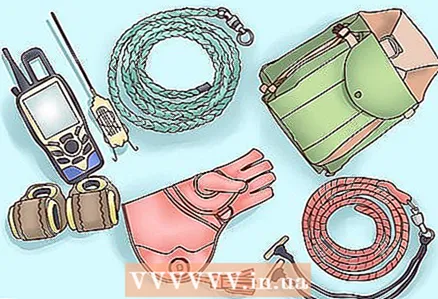
Content
- Steps
- Part 1 of 4: Make Sure You Are Ready
- Part 2 of 4: Become a Student
- Part 3 of 4: Get a bird
- Part 4 of 4: Keep Moving Forward
- Tips
- Warnings
Falconry is a fascinating and noble activity with a history dating back to ancient times, meaning hunting wild animals with trained birds of prey. Falconry is more serious than just a hobby; from beginners, it requires a significant amount of time and a lot of hard work (according to most sources, in order to fully master the skill, it takes two years of apprenticeship and seven or more years of practice). If you think you're ready for it, take the time to research the requirements and take the first steps towards becoming a true falconer.
Attention: This article applies to falconry in the United States. To find out how to become a falconer in Russia, contact your local society of hunters and fishermen (for example, for Moscow and the Moscow region, you will find information on the website www.mooir.ru).
Steps
Part 1 of 4: Make Sure You Are Ready
 1 Check with your local natural resources agency before starting. Laws governing falconry (like any other) may vary from region to region. Before considering falconry, check with your local natural resources organization to ensure that falconry is legal in your area and that you can meet all the requirements to practice it.
1 Check with your local natural resources agency before starting. Laws governing falconry (like any other) may vary from region to region. Before considering falconry, check with your local natural resources organization to ensure that falconry is legal in your area and that you can meet all the requirements to practice it. - A complete list of such organizations in the United States and Canada is available on the North American Falconry Association (NAFA) website.
- Attention: all instructions in this article are provided as a general guide. Always follow the advice of qualified professionals.
 2 Make sure you have enough time to become a falconer. The decision to become a falconer will affect your lifestyle for years to come. You should keep the following points in mind:
2 Make sure you have enough time to become a falconer. The decision to become a falconer will affect your lifestyle for years to come. You should keep the following points in mind: - The falconer training process is very long. As noted above, apprenticeship takes at least two years, and it will take seven or more years of practice to become a true falconer.
- A bird of prey requires almost constant care, without days off and holidays. It usually takes about half an hour a day (every day!), And on hunting days it takes four to five hours. If you are unable to take care of the bird personally (for example, going on vacation), you must agree to care for it during your absence.
- A healthy predator can live for over twenty years, although many falconers will eventually release captured birds back into the wild.
 3 Make sure you have the right temperament. Simply put, falconry is not for everyone. She can be very satisfying and rich in experience, but at the same time, being a falconer means doing things that will make some people dislike or disgust. They include:
3 Make sure you have the right temperament. Simply put, falconry is not for everyone. She can be very satisfying and rich in experience, but at the same time, being a falconer means doing things that will make some people dislike or disgust. They include: - Killing animals. Falconers use predators to hunt animals. This aspect requires honest self-assessment. How do you feel about killing wild animals? Are you emotionally ready to watch the predator overtake and kill the prey? Are you ready for the fact that the injured animals will have to finish off?
- If you are unsure, seriously consider trying more traditional forms of hunting first, with the entry barriers below for beginners.
- Keeping a bird of prey in a cage. Predators are usually kept in spacious aviary cages.In good conditions, birds are almost always contented and happy, but some people do not like the fact that wild animals are kept in captivity. Most environmental studies show that legal capture of birds for falconry has a very limited impact on the population.
- Bird cleaning and care. Predators are pretty clean, but being a falconer means being ready for the dirty work sometimes. For example, you may need to periodically clean the bird's cage, where droppings, bones, and other debris can accumulate over time.
- Killing animals. Falconers use predators to hunt animals. This aspect requires honest self-assessment. How do you feel about killing wild animals? Are you emotionally ready to watch the predator overtake and kill the prey? Are you ready for the fact that the injured animals will have to finish off?
 4 Make sure you have the resources the falconer needs. It is difficult to pinpoint the exact costs that you will incur as a falconer; the spread can be great. However, it is safe to say that falconry is by no means a cheap sport. For the entire life of a bird, you will spend at least a few thousand dollars on it. To be a falconer, you must be willing to take financial responsibility for keeping your birds. The costs you will need to pay include:
4 Make sure you have the resources the falconer needs. It is difficult to pinpoint the exact costs that you will incur as a falconer; the spread can be great. However, it is safe to say that falconry is by no means a cheap sport. For the entire life of a bird, you will spend at least a few thousand dollars on it. To be a falconer, you must be willing to take financial responsibility for keeping your birds. The costs you will need to pay include: - Poultry feed
- Veterinarian services
- Travel to meetings and hunting spots with fellow falconers.
- Payment of license and membership fees
- Aviary and equipment for poultry; find out if special inspection is required according to local legislation
- Books and reference materials
 5 Make sure you have access to appropriate land. To be a falconer, you need hunting grounds in which you can train and hunt your bird. Any area will not work - almost any site in a city or suburb is unsuitable for falconry. There should be enough game for hunting in the area.
5 Make sure you have access to appropriate land. To be a falconer, you need hunting grounds in which you can train and hunt your bird. Any area will not work - almost any site in a city or suburb is unsuitable for falconry. There should be enough game for hunting in the area. - Falcons require large areas to hunt from above, while hawks can hunt in small fields and meadows.
- Areas with roads, power lines, urban areas, barbed wire fences, and those where gun hunting is permitted are not suitable for falconry due to the potential health hazard to the bird or falconer.
- Even if you do not personally have such land at your disposal, some farmers will allow you to hunt on their land for free. Keep in mind that it is customary to offer farmers a small reward, such as organizing an annual party to show appreciation.
- If you have friends who own large tracts of land in the countryside, please note that you may still need written permission to use it as a hunting ground.
 6 Learn falconry. Still not sure if you want to become a falconer? One of the best ways to determine if you have the motivation and enthusiasm to become a falconer is to learn as much as you can about the sport. A passionate desire to learn about falconry from books, videos, expert stories, and other sources can be a sign of the genuine passion and dedication it takes to become a falconer.
6 Learn falconry. Still not sure if you want to become a falconer? One of the best ways to determine if you have the motivation and enthusiasm to become a falconer is to learn as much as you can about the sport. A passionate desire to learn about falconry from books, videos, expert stories, and other sources can be a sign of the genuine passion and dedication it takes to become a falconer. - A list of NAFA-recommended reading materials can be found here.
- Wildlife Ties (A bond with the wild) - An essay collection compiled by NAFA, is a great resource for beginners to grasp the essence of falconry.
- Try chatting with falconers on forums or blogs on the Internet. The International Falconry Forum is an excellent opportunity for professionals and beginners alike to discuss the pleasures of this activity.
Part 2 of 4: Become a Student
 1 Check with your local authority to find out what permits you need. You can't just go and catch a bird. Birds of prey are protected by local, federal or international laws, and you will need to obtain the necessary permits and licenses before you can fish or start hunting.Contact your local natural resources agency as early as possible so that you have sufficient time to fulfill all the prescribed requirements for legally practicing falconry.
1 Check with your local authority to find out what permits you need. You can't just go and catch a bird. Birds of prey are protected by local, federal or international laws, and you will need to obtain the necessary permits and licenses before you can fish or start hunting.Contact your local natural resources agency as early as possible so that you have sufficient time to fulfill all the prescribed requirements for legally practicing falconry. - It takes a long time to obtain these permits, so it is important to plan ahead. Most sources recommend applying for permits a year before the start of the hunting season in which you intend to start.
- Be aware that in addition to a permit to catch and keep birds, you may need a standard hunting license, which will require you to complete a preparatory course.
- At this stage, you are likely to sign up for an exam to be taken to obtain authorization. Read more below.
- As a reminder, here is the NAFA-recommended list of wildlife agencies operating in the United States and Canada.
 2 Contact your local falconry organization. While you are waiting for the authorities to process your request, contact your nearest falconry club to begin the apprenticeship process. Not all states, provinces, or regions have such organizations, but many do.
2 Contact your local falconry organization. While you are waiting for the authorities to process your request, contact your nearest falconry club to begin the apprenticeship process. Not all states, provinces, or regions have such organizations, but many do. - Here you will find a list of NAFA member falconry clubs.
- Start attending meetings at the falconry club even if you haven't gotten permission to practice yet. It's a great way to meet people, get to know the sport better, and develop friendships that can then turn into mentoring.
 3 Find a mentor. In the process of training, falconers undergo three levels of training: an apprentice falconer, an ordinary falconer and a master falconer.As an apprentice, you must have a mentor for at least two years. The mentor can be an ordinary falconer or a master falconer. Different clubs, different people have different requirements for potential students - some mentors even require that the person who wants to become a falconer be trained next to them for at least a year, and only then they decide whether to take him or her as an apprentice.
3 Find a mentor. In the process of training, falconers undergo three levels of training: an apprentice falconer, an ordinary falconer and a master falconer.As an apprentice, you must have a mentor for at least two years. The mentor can be an ordinary falconer or a master falconer. Different clubs, different people have different requirements for potential students - some mentors even require that the person who wants to become a falconer be trained next to them for at least a year, and only then they decide whether to take him or her as an apprentice. - Your mentor will be one of the most important figures during your apprenticeship. This person will help you learn, guide and advise you for several years. Choose someone you enjoy spending time with and whose opinion you respect.
- It is much easier to persuade an experienced falconer to become your mentor if you know the person well. and if he thinks you are knowledgeable enough about falconry. Surely you will start going to falconers' meetings and read the materials mentioned above on the topic in order to understand the essence and terminology of falconry over time.
 4 Take the falconry exam to get a permit. Almost everywhere you live, you must pass a written examination by your local natural resources agency before obtaining a license or permit. The exam will test your knowledge of birds of prey, their characteristics, health and care, laws governing falconry, and the like.
4 Take the falconry exam to get a permit. Almost everywhere you live, you must pass a written examination by your local natural resources agency before obtaining a license or permit. The exam will test your knowledge of birds of prey, their characteristics, health and care, laws governing falconry, and the like. - Most likely, you will want to take the exam in advance with a large margin of time (perhaps even as soon as you contact the appropriate organization). The exam is usually paid and takes place only on certain dates throughout the year, depending on where you live.
- This site contains examples of exam tests conducted in Utah. No answers are given here, but you can answer the questions and email them to see the result.
- Note that some states require a mentor to be found before passing the exam, while others do not. Check with your local agency for specific requirements.
Part 3 of 4: Get a bird
 1 First, build a poultry enclosure. As noted above, birds of prey are kept in large enclosures.Before catching or buying a bird, make sure you have the right conditions for keeping it. Under the guidance of your mentor (and not forgetting local laws and regulations), make a home for your bird. Generally, containment conditions are checked by the local natural resources agency., and only then you can get a bird of prey.
1 First, build a poultry enclosure. As noted above, birds of prey are kept in large enclosures.Before catching or buying a bird, make sure you have the right conditions for keeping it. Under the guidance of your mentor (and not forgetting local laws and regulations), make a home for your bird. Generally, containment conditions are checked by the local natural resources agency., and only then you can get a bird of prey. - The aviary can be made of wood or fiberglass (fiberglass). Do not use poultry netting. The floor can be left earthen, covered with fine gravel or sawdust, or concreted. There should be roosts inside, at least one of which is by the window. For one bird, a space of at least 1.8 x 2.4 m and a height of 2.1 m is required; for two birds, respectively, you will need a twice as large house, divided in the middle by a wall. Often you may be required to attach a walking yard to the enclosed enclosure, where the bird will be tethered.
- Poultry housing requirements vary from region to region, so check with your local agency for the exact details.
- You will also need a bathing container and an accurate scale to keep track of your bird's health.
- The aviary can be made of wood or fiberglass (fiberglass). Do not use poultry netting. The floor can be left earthen, covered with fine gravel or sawdust, or concreted. There should be roosts inside, at least one of which is by the window. For one bird, a space of at least 1.8 x 2.4 m and a height of 2.1 m is required; for two birds, respectively, you will need a twice as large house, divided in the middle by a wall. Often you may be required to attach a walking yard to the enclosed enclosure, where the bird will be tethered.
 2 Do it yourself or buy ammunition. Falconry requires special equipment. Ammunition requirements may vary depending on bird species and local laws and regulations, so check with your falconry club for a list. Making homemade ammunition is often cheaper than buying, and if you are serious about falconry, this will be a useful skill for you. but, your ammunition, as well as the conditions of keeping the birds, will almost always be checked for quality, so take it on yourself only if you are an experienced craftsman.
2 Do it yourself or buy ammunition. Falconry requires special equipment. Ammunition requirements may vary depending on bird species and local laws and regulations, so check with your falconry club for a list. Making homemade ammunition is often cheaper than buying, and if you are serious about falconry, this will be a useful skill for you. but, your ammunition, as well as the conditions of keeping the birds, will almost always be checked for quality, so take it on yourself only if you are an experienced craftsman. - In most cases, you will need tails (straps that are worn on the paws of a bird) or cuffs with a ring, an identification ring, (braided "leash"), a cord (long, for training a bird), a glove (special, for the left hand), a hood , stubs (leather strips to which the debtor will be attached), a swivel for attaching the debtor, the debtor itself (a braided "leash"), bait (for training) and telemetry (to determine the location of the bird when it is out of sight).
 3 Catch the bird. Many mentors require the student to catch the first bird himself. In the United States, students only young red-tailed buzzards or passerine kestrels of any age are allowed to be caught (with the exception of Alaska, where you can also catch goshawk). Although catching is allowed in most regions at any time of the year, most sources recommend catching it in the fall or early winter, as this will give the young bird plenty of time to become a skilled hunter - but it can still be tamed. Please be aware that in the US, students are not allowed to buy hunting birds.
3 Catch the bird. Many mentors require the student to catch the first bird himself. In the United States, students only young red-tailed buzzards or passerine kestrels of any age are allowed to be caught (with the exception of Alaska, where you can also catch goshawk). Although catching is allowed in most regions at any time of the year, most sources recommend catching it in the fall or early winter, as this will give the young bird plenty of time to become a skilled hunter - but it can still be tamed. Please be aware that in the US, students are not allowed to buy hunting birds. - Capturing a bird of prey is too complex a topic to cover in detail in this article. A great first time guide would be a dedicated article on her at The Modern Apprentice.
- Get your mentor's permission before trying to catch your first bird. Also, make sure that all your applications are approved, the fees have been paid, and you have all the necessary documentation on hand - and only then can you get your first bird.
 4 Fill out the paperwork and ring the bird. Once you catch a bird, you should ring it in case it flies away and someone finds it. Depending on where you live, you may be required to complete paperwork to register your bird; check with your local agency for more information.
4 Fill out the paperwork and ring the bird. Once you catch a bird, you should ring it in case it flies away and someone finds it. Depending on where you live, you may be required to complete paperwork to register your bird; check with your local agency for more information. - In the United States, the filing period is 10 days after the bird is caught.
Part 4 of 4: Keep Moving Forward
 1 Start training your bird. Now that you've caught your first bird, you are officially considered an apprentice falconer.Follow your mentor's directions carefully and be patient - it usually takes about six weeks to teach a bird to hunt. Find an article on training falcons on our website.
1 Start training your bird. Now that you've caught your first bird, you are officially considered an apprentice falconer.Follow your mentor's directions carefully and be patient - it usually takes about six weeks to teach a bird to hunt. Find an article on training falcons on our website. - In addition, the 1997 issue of Hawk Chalk Magazine (the official NAFA news magazine) has an excellent article on a technique called operant training for training birds of prey. You can find it here.
 2 Achieve the status of a regular falconer (and eventually a master falconer). As you move up the falconer hierarchy, you will gain more freedom and privilege than a student has. Below is an example of a brief description of each rank according to the classification adopted in the state of Washington (it will be similar in most other places):
2 Achieve the status of a regular falconer (and eventually a master falconer). As you move up the falconer hierarchy, you will gain more freedom and privilege than a student has. Below is an example of a brief description of each rank according to the classification adopted in the state of Washington (it will be similar in most other places): - Falconer Apprentice
- Has the right to keep only one bird
- He can only catch a passerine kestrel or a red-tailed hawk by himself (in Alaska, a goshawk is allowed).
- Must train mostly with a mentor.
- Common falconer
- Can hold up to three captured birds at the same time.
- Can catch several other bird species (see WAC 232-30-152 for more information).
- After two years in ordinary status, he can take a student.
- Falcon Master
- Must "have at least five years of experience as a general falconer and demonstrate competence in successful hunting and bird care, and have practice with more than one species of prey."
- Can hold up to five captured birds at a time.
- Can hold an unlimited number of captive birds for falconry.
- Falconer Apprentice
 3 Join NAFA. Most falconers join NAFA, the North American Falconry Association, as apprentices. Membership in NAFA provides many privileges, including access to falconry news, learning resources, discussion groups, and more. To join NAFA, applicants must complete a simple application form (complete online and print here). The membership fee must be paid immediately upon submission of the application and then paid once a year. For North Americans, membership costs $ 45 per year, while for foreigners it will cost $ 65 per year.
3 Join NAFA. Most falconers join NAFA, the North American Falconry Association, as apprentices. Membership in NAFA provides many privileges, including access to falconry news, learning resources, discussion groups, and more. To join NAFA, applicants must complete a simple application form (complete online and print here). The membership fee must be paid immediately upon submission of the application and then paid once a year. For North Americans, membership costs $ 45 per year, while for foreigners it will cost $ 65 per year. - Also, plan to join the state or provincial falconry association (if there is one). For example, Washington State falconers should join the Washington Falconers Association.
Tips
- Make sure you are ready to devote at least half an hour a day to your bird, and during the hunting season to hunt with it 3 to 6 times a week.
- Study diligently and learn everything you can before you start hunting. Don't be afraid to ask; there are no stupid questions.
- In the United States, federal law sets the minimum age for falconry to be 12 years old, but local laws may set a different age. Check local regulations for young falconers.
- It is worth noting that birds that are not falcons as such, for example, hawks or buzzards, are also used for falconry.
Warnings
- For safety reasons, get a tetanus shot before becoming a falconer. Prevention is the best medicine, so it is definitely worth preparing.
- Never harm birds!



